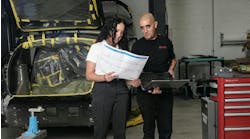Occupancy-status (OS) technology is the future of vehicle safety systems. Already a part of many commercial fleets, the use of OS in detecting passengers such as children is a logical next step into a new frontier.
In fact, it’s already gaining regulatory traction and industrywide adoption. Euro NCAP (New Car Assessment Programm) will incentivize automakers that offer the system in 2022, and members of the Alliance of Automobile Manufacturers, and the Association of Global Automakers are willing to make occupancy monitoring a standard feature by 2025.
What’s driving this change? Why is occupant status such a critical aspect to the future of mobility? The simple answer is the emergence of autonomous vehicles and increasing automation in non-autonomous vehicles. Detection technology like OS is supportive in its ability to identify everything, from occupant behavior and state, to emergencies, attentiveness, and more.
The point is that technology helps make vehicle travel safer and will continue to evolve with changing needs. As such, the application of OS, while far removed from that old tire air-pressure gauge, represents a future where passenger safety — including pets — must account for more automated, as well as self-driven and autonomous, experiences. Xperi’s DTS AutoSense was developed and designed to do just this, for the following reasons:
Safety during changing environments: OS technology is needed to handle a variety of changes at any time, including passenger control, autonomous environment, partial autonomous, and emergency passenger control. To that end, it should provide an overview of the full cabin interior with the ability to analyze with frame accuracy.
Occupant positioning: While we can acknowledge that passengers should sit and behave in a safe manner, they often don’t, especially children. OS technology can analyze and issue a warning, and airbags can be deployed based on each passenger pose and exposure to an accident. This technology, which can deploy the airbags in a controlled manner aligned with passenger ID, also provides customized traveling experiences (load-specific setup, temperature, lighting, sound, etc.).
Occupancy behavior: In a more autonomous future, safety regulation organizations will need to understand far more than simple seat occupancy. By developing a rear-view mirror camera stream, analyzed by various neural-network-based algorithms, the holistic in-cabin sensing system allows for more behavioral context that can be scored by any regulatory institute.
Occupancy experience: It’s not just about safety. OS monitoring will enable a better journey experience through the personalization of music, lighting schemes, seat adjustments, and more — all based on passenger ID, location, behavior, and activity. Imagine having a playlist selected for you based on your mood, as detected through activity and analysis.
Accomplishing this was a significant challenge. Industry sentiment was, at the time, leaning toward the impossibility of performing both driver and passenger simultaneous sensing from a single camera. The biggest identified problem was the rearview mirror angle. Mounted in this position, the camera wasn’t facing the driver frontally, which directly affected the efficacy of the driver sensing technology.
How the technology was developed
The core technology behind the DTS AutoSense Occupancy Monitoring System (OMS) leverages machine-learning and neural-processing advances in computer vision, raising quality and performance to new levels. With careful use of data, KPIs for detection, classification, and recognition reach the upper 90 percentiles.
The availability of relevant data with high-quality annotations is key to performance, which is why DTS invested heavily in all aspects of data infrastructure, from acquisition and generation, validation, evaluation, storage, retrieval, and computer power to a skilled workforce dedicated to using and managing it. As a result, the OS solution is fully neural, based on custom convolutional neural networks (CNNs) that combine cascading detectors for body, face, and generic objects to generate in-cabin context and act on it. They also deploy a complex lens distortion correction process, followed by a customized image-processing sequence with an in-cabin 3D space positioning of occupants.
The solution is camera agnostic, so the OS has the capability of correcting the feed of any camera and lens system in any existing in-cabin space. The solution runs on an RGB-IR (red-green-blue infrared)/IR sensor, be it on a single RGB stream, a cumulated RGB-IR, or only on a pure IR one.
The OS solution runs in real-time in any vehicle cabin and can offer feedback and/or directly report on passenger status. If a seat in the vehicle is occupied, this position will be detected, recorded, reported, and actualized in real-time.
Developmental challenges
Developing nascent technology and creating novel, undefined use cases presented our team with some major challenges. As the OS was being built, it encountered unforeseen side effects. Each of these had to be addressed, solved, cataloged, and classified to advance.
Ultimately, it demanded a new level of mastery, including the development of new acquisition systems, data marking, additional notation requirements and processes, and a complete refining of our neural training approach. Here are a few of the challenges, and how they were solved:
Keeping driver monitoring system (DMS) accuracy as high as existing solutions: Some might assume that a single-camera solution (running DMS and OMS from a rear mirror) versus only a frontal camera could affect accuracy. However, a much broader context is available from the rear mirror, meaning the same or even higher accuracy is achieved by analyzing the extended landscape of the driver.
Backseat obstruction rate: Another big challenge involved handling the obstruction rate of backseat passengers (the front seat always occludes the rear subjects to some degree). To overcome these issues a temporal analysis of the activities and behaviors of the passengers was applied. This analysis creates a complex algorithm that tracks activities (sleeping, talking, using gadgets, body movement, pose, appearing/disappearing objects, etc.) over a period of time, for each occupant independently, and then saves a history of it. Based on this information, probabilities for the objects (occluded or not) and the resulting specific behaviors (observable or not) can be calculated. Valid decisions/warnings are issued only after analyzing the history of these activities and behaviors as a whole.
Detection of occupants: Detecting occupants outside the in-cabin space area presented a unique challenge. OMS enabled in-cabin occupancy solely with computer vision and RGB-IR or IR sensors. A side effect of that detection technology was it detected people outside and inside the car, impacting the solution’s effectiveness.
As the technology navigated through these challenges, it developed specific data-acquisition scenarios and perfected a custom infrastructure that was able to design solutions for issues particular to this technology.
How testing was conducted
The complexity of these challenges required rigorous analysis and testing, including evaluation contexts, specific scenarios, poses behaviors, and occlusions. A variety of factors were factored in, including cabin size and form, day vs. night light, and high occlusion rates. Then, the OS collected real traveling scenarios from different vehicles with a variety of passengers (up to five) and at multiple traveling lengths and landscapes.
Sensor and image quality were critically important. Problems were caused mainly by noise, overexposure (extreme sunlight), underexposure (low-light condition) issues caused by the mixed IR and visible domains, fast ambient light transitions (entering a tunnel), shadows in-cabin and on passengers, as well as varying ambient lighting, color, and intensity.
During these different lighting scenarios, passengers were engaged in a variety of activities and poses, which were validated/annotated by specific hardware systems and further analyzed by a skilled data team.
Overall, it took the team years of ideation, development, testing, and more testing to create a truly accurate OS system for passenger vehicles. Clearly, the number of in-cabin features provided by car makers will increase, and, as such, they will need to have a corresponding number of safety elements and use cases — that will be critical.
This article originally appeared in Electronic Design, a publication of Endeavor Business Media.



